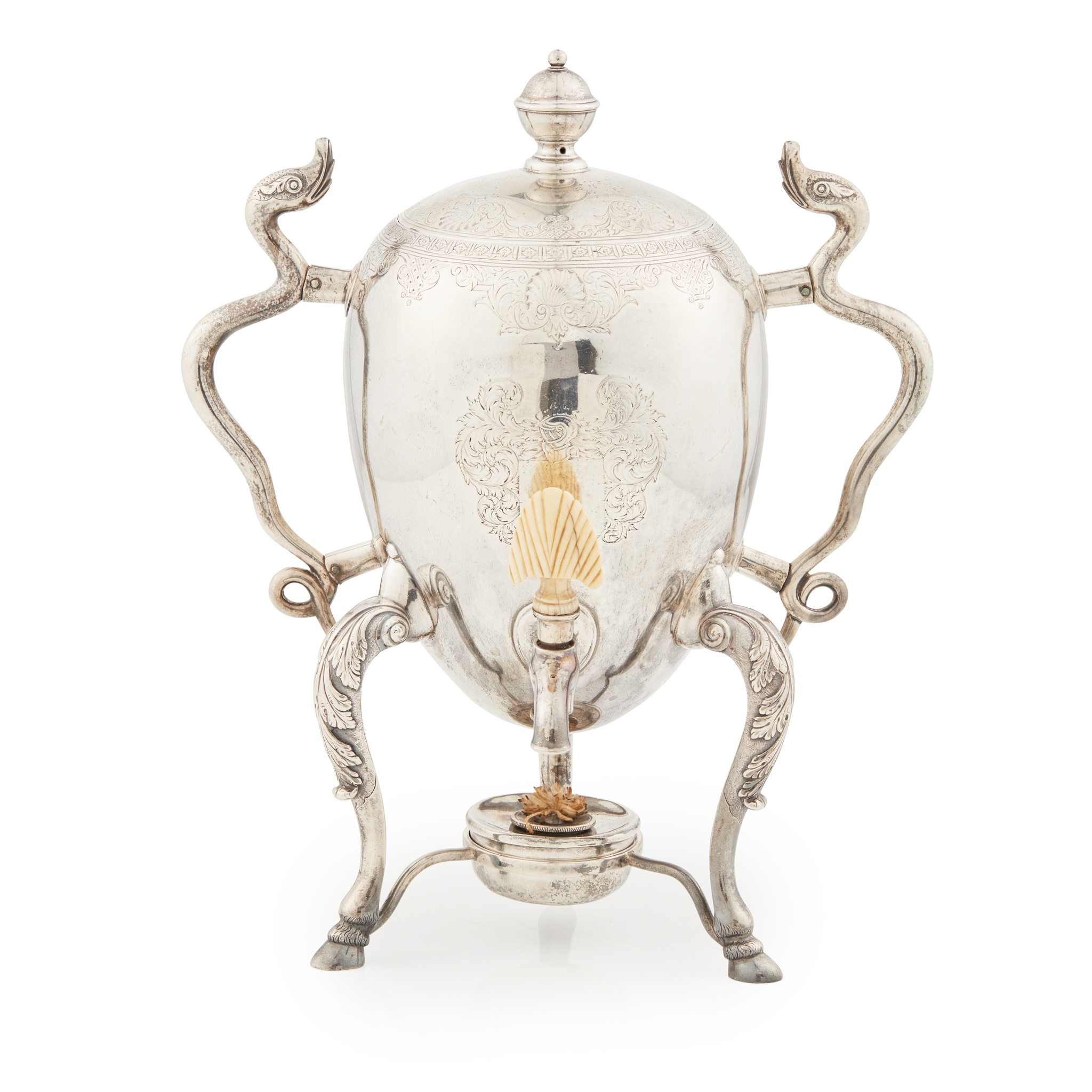A RARE SCOTTISH GEORGE II COFFEE URN Y
ATTRIBUTED TO JAMES KERR, EDINBURGH, CIRCA 1730
£11,875
Auction: 6 October 2021 at 10:00 BST
Description
The ovoid body raised on three cabriole legs, with a chased border of shells and diaper work around the shoulder and cover, with a vacant cartouche (previously engraved), with later spirit lamp
Dimensions
Height: 31cm, weight (all in): 52.9oz
Footnote
Note: This newly discovered mid 18th century Edinburgh coffee urn adds to a small but important group of Scottish silver, arguably without compare. Bringing the survival to approximately seventeen (with eleven in institutions), this urn fits perfectly within the Golden Age of Edinburgh silver.
With no parallel elsewhere in England or the rest of Europe, where the inspiration for this design emanates from is still the subject of debate, although the basic shape may derive something from the earlier practice of mounting ostrich eggs in silver.
During the period of these urns manufacture (circa 1719 - 1767) and particularly within the height of their manufacture (circa 1730 -1750) the number of standard pouring coffee pots is minimal. This and a reference in the John Rollo, Goldsmith Edinburgh, account book 'To one Coffe poot 62 oz 2dr at 7sh 6pe per oz - £23 - 5 - 8' and the survival of this piece adds great weight to the theory of their use being for coffee, rather than as hot water or tea.
Their functionality also is worthy of note, when it is considered that within contemporary accounts coffee is considered medicinal and should 'be drunk as hot as one can bear' the shape combined with the use of a burner (now lacking in most of extant examples) would have meant the contents could have been kept hot.
The design of these urns seems to vary more by the period than maker, with the flair of the maker coming in the outline shape of the body; they can vary from elongated to more compressed squat forms. All but one of the surviving urns are of Edinburgh manufacture and by a small but highly regarded group of makers. The exception is a Dundee marked example by Alexander Johnston, which while marked by him and the body likely made by him, the cast elements (legs, handles etc.) appear to emanate from one of the Edinburgh makers, likely James Kerr. Research continues but it would appear that all seventeen urns could have these cast elements emanating from as few as three original workshops, although the number of makers marks struck to them is greater.
While the marks to this example are now all but obliterated, it does seem possible to suggest a maker, comparing stylistic trends of shape, decoration and cast elements. The most likely candidate appears to be the highly regarded Edinburgh silversmith James Kerr, who would latterly go into partnership with William Dempster becoming Kerr & Dempster. On earlier examples Kerr’s mark is prolific and on later examples the partnerships maker's mark is also seen.
Perhaps most telling is the delicately flat chased decoration and diaper work to the neck which is reminiscent of Kerr’s work on bullet teapots of the same period. The cast legs with their acanthus clasped tops, with plain rat tail rib and the raised hoof feet are also a mould recognised as coming from the Kerr workshop. Access to prepared moulds in the workshop must suggest a place of manufacture similar to the other urns featuring these patterns. The crossover of makers using the same moulds and patterns for handles, legs and spigot does add some confusion to these theories, but the majority of urns using these moulds can be tied to the Kerr (and latterly Kerr & Dempster) workshop.
It is also worth noting that James Kerr was responsible for the creation of the Hopetoun tea and coffee service (originally commissioned with an ovoid coffee urn, now lost) and similarities can be seen with the light diaper work of the 18th century and hoof feet of the spirit kettle held in the collection of The National Museums of Scotland.
This piece certainly pre-dates his partnership with William Dempster in 1751, so it seems safe to ascribe James Kerr’s name alone to this work. This urn is also rare in that it was made with an integral placement for the spirit lamp burner.
Please be aware that this lot contains material which may be subject to import/export restrictions, especially outside the EU, due to CITES regulations. Please note it is the buyer's sole responsibility to obtain any relevant export or import licence. For more information visit http://www.defra.gov.uk/ahvla-en/imports-exports/cites/

